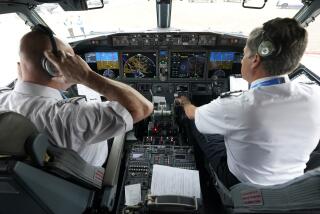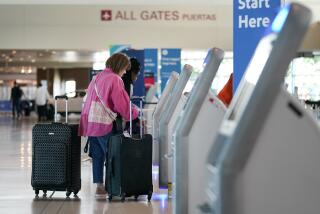Airline Cuts May Reduce Quality of Future Pilots : Safety: Few recruits are entering the training pipeline, because few jobs are available. Since a third of flight crews will retire over next decade, replacements may lack experience.
- Share via
FT. WORTH, Tex. — Judy Tarver has little time to worry about the pilot shortage projected for the near future.
The manager of American Airlines’ pilot recruitment department, Tarver has a more immediate problem: What will her job be now that American has placed a freeze on hires and is closing her office?
After the heady expansion of the 1980s, American and other airlines are cutting back. New plane orders are being delayed or canceled; old planes are being retired ahead of schedule.
It is a buyer’s market for airline pilots.
American plans to furlough 500 of its 10,000 pilots by early 1994. Seven thousand piloting jobs already have vanished in the failures of Eastern, Pan Am and Midway airlines and cutbacks at other carriers.
“We were one of the few airlines doing any hiring at all,” Tarver said.
At American’s flight academy complex, Capt. Lee Schumacher also is dealing with retrenchment. Where he once trained 800 new pilots a year, Schumacher is concentrating more on the retraining of American crews.
“We are easing back a bit,” he said. “When the airline was expanding, we had people moving from plane to plane. That isn’t happening now.”
Although the cuts in air crews may be economic necessity, they couldn’t come at a worse time in relation to the future supply of airline crews. Over the next decade, about 23,000 pilots will hit retirement age, which translates to a loss of a third of the crews now flying.
At a time when new pilots should be entering the training pipeline, the opposite is happening.
The military, once a major supplier of well-trained, experienced pilots, is scaling back. And enrollment at flight academies and aeronautic universities has been dropping as potential students weigh the risks of spending six figures for jobs that don’t exist right now.
As a result, when the industry turns around again, airlines might have to settle for pilots with less experience and solid training.
“If traffic picks up, if they have more demand for seats in the back, you could see a strain in the qualification limits for new pilots,” said Louis Smith, president of FAPA, an Atlanta-based aviation career-counseling firm.
According to a FAPA poll, pilots hired by major airlines over the last few years had an average of about 1,900 hours of jet experience, a figure slightly inflated by the number of experienced pilots looking for work.
But over the next few years, that level of experience is expected to drop precipitously. Even airline executives predict that by decade’s end, they will be hiring more and more pilots with less than 500 hours’ flying experience.
“Today, we’re still able to get a lot of experienced applicants in their 40s and early 50s,” said John Kern, vice president of flight operations at Northwest Airlines. “Once we clean out that population, it won’t be long until we’re looking at these bright young people with less hours.”
It won’t be the first time airlines took on “low-time” pilots. TWA Capt. Bob Pastore had just 200 hours when he was hired in 1966, a time of rapid expansion for the airlines.
But there was a significant difference. At that time, all airliners had three-member crews, so new hires started out as non-flying flight engineers. By the end of this decade, nearly all the major airliners will have two-crew cockpits.
“Back then, the airlines enjoyed the advantage of starting someone out as a flight engineer who got to sit behind an experienced captain who was probably military-trained,” said Pastore, chairman of the Air Line Pilot Assn.’s training and review task force.
“You were in a learning situation without worrying about the unknown of whether you could really fly the airplane,” he said. “A lot of people were weeded out that way.”
In the future, it is likely that a new hire’s first time at the co-pilot controls of a regularly scheduled airline flight will be made after two to three months of simulator training.
The hires’ prior experience will be a mixed bag. Some will come from flight schools and aeronautics colleges with about 500 hours flying time, others from commuter airlines with about 1,500 hours.
The notion of commercial cockpits populated by people with less experience and a mix of training disciplines worries Kenneth Tallman, a former Air Force general who heads a federal panel looking into the projected shortages of pilots and mechanics.
“Most of these people will be coming from schools with only 350 hours,” he said. “You can’t put that kind of person in the right seat of an airliner.”
But airline officials disagree. The level of training is better, they say, including the use of realistic simulators that can test a pilot’s skills in emergency situations better than actual flight experience.
“We do some sophisticated testing,” said Bill Traub, vice president of flight training at United Airlines. “Less than an hour in the simulator can tell us the skill level of a pilot.”
They also disagree with projections that the pool of pilots will dip so low that airlines will have to settle for low-time pilots.
“For the next five years, we will have an adequate supply of pilots as the commuters continue to grow,” Schumacher said. “As long as we’re the big leagues, we’ll always have the opportunity to choose from the commuters, contract and corporate pilots.”
But across the road, in the hush of her empty office, Judy Tarver worries that the dropping interest in piloting as a career may catch up with the industry.
“The major carriers will find good people through the commuters, but the commuters will have to be concerned about a good supply of pilots,” she said. “I think the interest about piloting has to be stimulated. People are not getting into the industry as pilots.”
More to Read
Inside the business of entertainment
The Wide Shot brings you news, analysis and insights on everything from streaming wars to production — and what it all means for the future.
You may occasionally receive promotional content from the Los Angeles Times.










